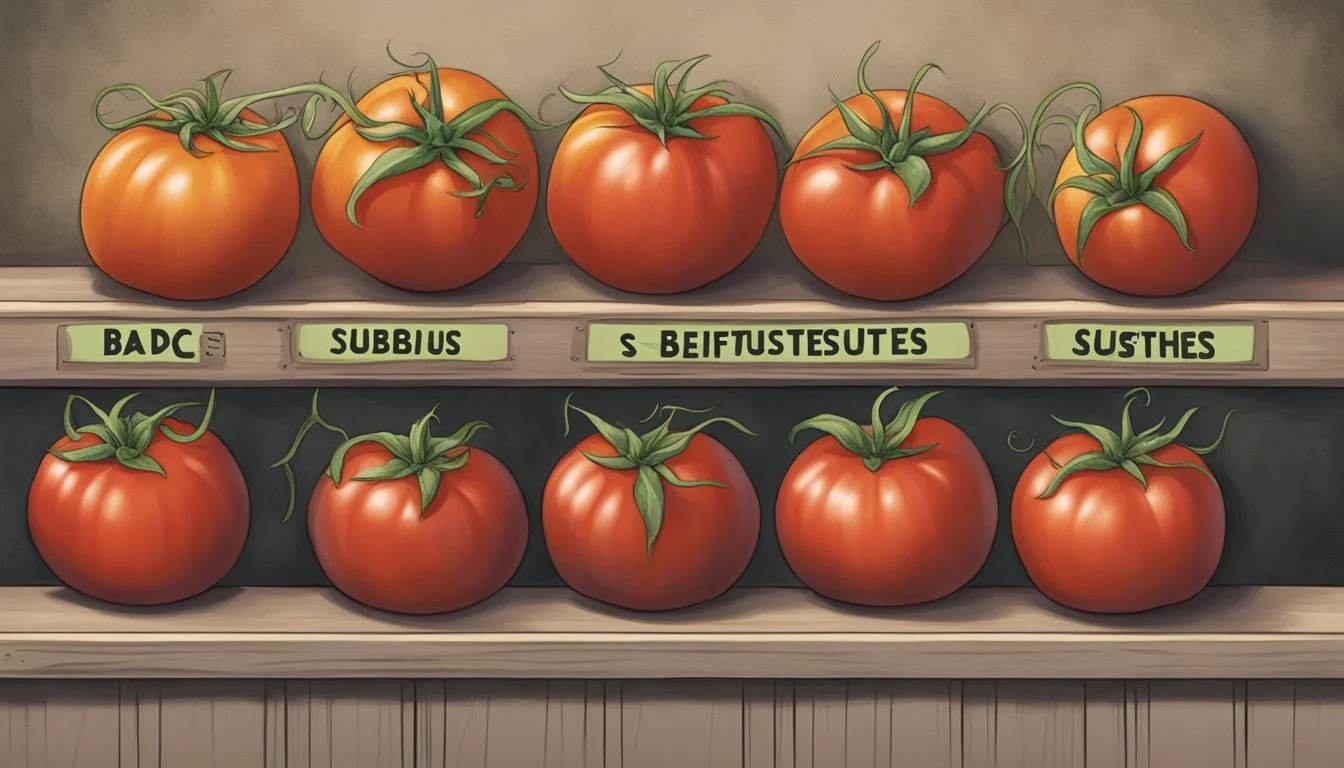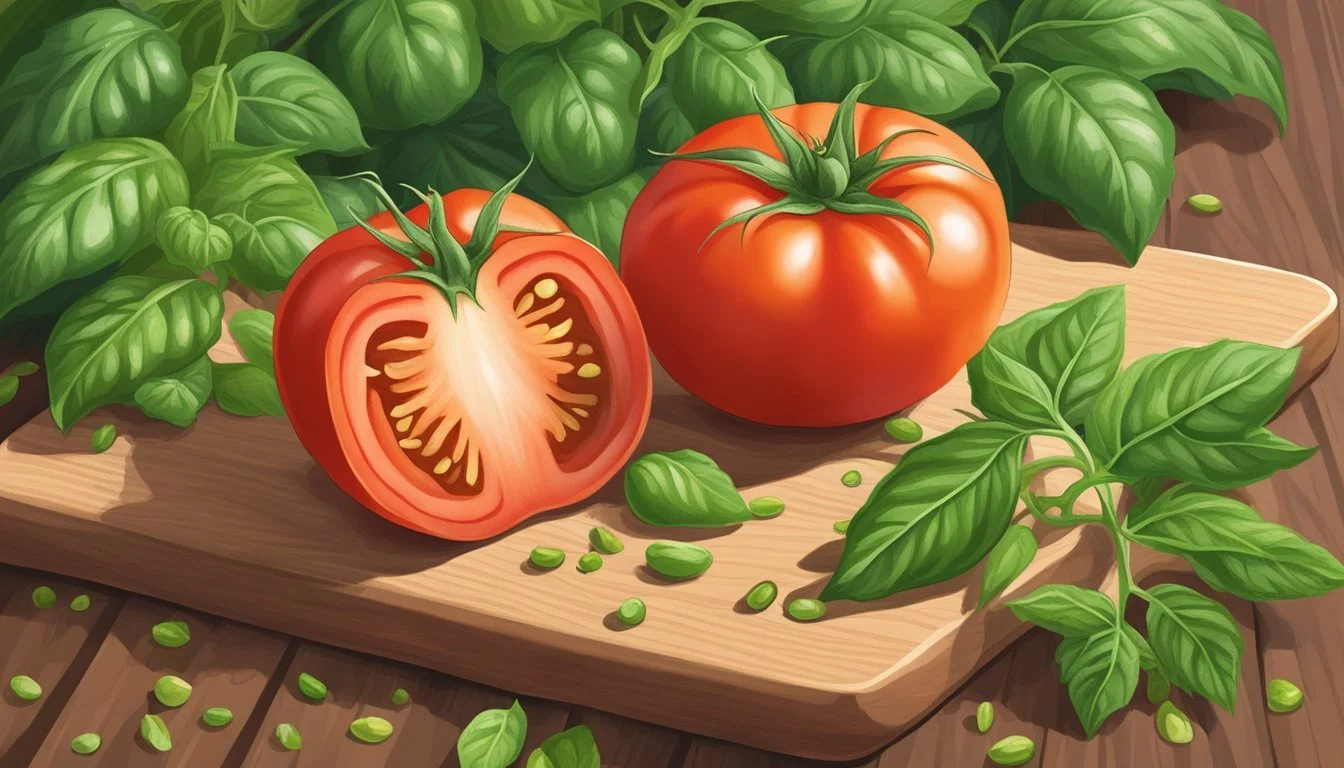Beefsteak Tomatoes Substitutes
Best Alternatives for Any Recipe
Discovering the perfect substitute for beefsteak tomatoes can transform your culinary creations, especially if you’re crafting salads, sandwiches, or simply need a reliable slicing tomato. Plum tomatoes are an excellent alternative, thanks to their fleshy texture and robust flavor, making them ideal for soups and sauces where beefsteak tomatoes typically shine.
Another option to consider is vine-ripened tomatoes. These tomatoes, particularly the larger varieties, balance sweetness and acidity, closely mimicking the profile of beefsteak tomatoes. For those seeking rich and complex flavors, heirloom varieties like Brandywine or Mortgage Lifter provide a delightful substitute, enhancing any dish with their depth.
In contexts where fresh tomatoes aren't essential, tamarind paste can be used in curries to replicate the tangy notes of beefsteak tomatoes. Each substitute offers a unique twist, ensuring your dishes remain flavorful and enjoyable despite the absence of the classic beefsteak tomato.
Understanding Beefsteak Tomatoes
Beefsteak tomatoes are known for their large size, juicy texture, and rich flavor. They are prized in home gardens and culinary uses, especially for slicing and fresh consumption.
Varieties of Beefsteak Tomatoes
Beefsteak tomatoes come in a variety of types, each with unique attributes. Heirloom varieties like Brandywine, Cherokee Purple, Black Krim, and Mortgage Lifter are cherished for their diverse colors and robust flavors.
Hybrid varieties include Big Beef, which offers disease resistance and reliable yields. These hybrids are often preferred for their resilience in various growing conditions. Both heirloom and hybrid varieties demand full sunlight and well-drained, nutrient-rich soil for optimal growth.
Characteristics and Uses
Beefsteak tomatoes are characterized by their large size and meaty texture, making them ideal for slicing. Their vibrant colors range from deep reds to purples and even nearly black hues. These tomatoes are perfect for sandwiches, burgers, and fresh salads due to their juiciness.
They also excel in culinary applications such as making rich sauces and canning. The intense flavor and substantial flesh add depth to dishes, while their lower water content compared to other tomato varieties helps in creating thicker, more concentrated sauces.
Cultivation Practices
Cultivating substitutes for beefsteak tomatoes requires careful attention to soil quality, sunlight, watering practices, support structures, and proper fertilization. These factors ensure robust plant growth and high-quality fruit production.
Soil and Planting
Tomato plants thrive best in fertile, well-drained soil rich in organic matter. Prior to planting, amend the soil with compost to enhance nutrients and improve texture. A soil pH between 6.0 and 6.8 is ideal.
Seeds or seedlings should be planted in warm soil, ideally between 60°F and 90°F. Space the plants about 18 to 24 inches apart to allow for adequate airflow and root expansion. Raised beds or containers with good drainage also provide suitable environments.
Sunlight and Watering
Tomatoes need full sun exposure, requiring at least 6-8 hours of direct sunlight daily. Position the plants in a sunny spot of the vegetable garden to maximize photosynthesis and growth.
Consistent moisture is vital. Water deeply at the base of the plants and maintain even soil moisture, avoiding overhead watering to reduce leaf disease. Drip irrigation systems are effective in delivering controlled water directly to the roots while conserving water.
Support and Space
Tomato vines need solid support to grow effectively. Use stakes, cages, or trellises to keep the plants upright and prevent the fruit from touching the ground, which can reduce disease and pest issues.
When spacing, plant tomatoes approximately 24 inches apart in rows spaced about 36 to 48 inches apart. This spacing ensures that each plant has sufficient room to spread and access sunlight and nutrients.
Fertilization and Maintenance
Proper fertilization and maintenance are crucial. Tomatoes benefit from a balanced fertilizer, such as a 10-10-10 or 5-10-10 blend, which provides essential nitrogen, phosphorus, and potassium. Organic fertilizers like compost or well-rotted manure can also be used.
Throughout the growing season, monitor the plants for signs of nutrient deficiencies or pests. Mulching around the base helps retain moisture and control weeds. Regular pruning of the lower leaves and suckers promotes airflow and reduces disease risks, ensuring healthy and productive plants.
Common Challenges in Growing
Growing beefsteak tomatoes can be rewarding but comes with several challenges related to pests, diseases, and environmental stress. Proper maintenance and timely interventions can mitigate these issues significantly.
Pests and Diseases
Pests such as aphids, tomato hornworms, and flea beetles pose significant threats. Aphids cluster on the undersides of leaves, sucking sap and weakening the plant. Regular inspection and using insecticidal soap can control their spread.
Tomato hornworms are large, green caterpillars that can strip leaves quickly. Handpicking and natural predators like parasitic wasps are effective control measures. Flea beetles create small holes in leaves and can stunt growth. Floating row covers can protect young plants from these beetles.
Diseases like early and late blight are common. Early blight causes leaf spots and can be controlled with proper air circulation and crop rotation. Late blight, a more severe threat, results in dark spots on leaves and stems. Fungicide applications and removing infected plants promptly help curb its spread.
Environmental Stress
Environmental factors such as temperature fluctuations and poor air circulation significantly stress tomato plants. Temperatures above 90°F can hinder fruit set and cause leaf curl. Similarly, cold temperatures delay growth and can damage leaves.
Consistent watering prevents issues like blossom end rot, which is caused by calcium deficiency due to irregular moisture levels. Maintaining soil moisture with mulch helps stabilize temperature and moisture. Proper spacing ensures each plant has adequate air circulation, reducing the risk of fungal diseases.
Strong winds can also damage plants by breaking stems and leaves. Staking or caging plants offers physical support. In extreme heat, providing some shade during peak sun hours can protect leaves and fruits from sunscald.
Harvesting and Post-Harvest
Harvesting beefsteak tomatoes at the right time is crucial for the best taste and texture. Proper storage and preservation methods can extend their freshness and usability in dishes like sauces and canning.
When and How to Harvest
Beefsteak tomatoes are typically ready for harvest when they reach their full color, which is often a deep red but can vary by variety. The large fruit should feel slightly soft to the touch, indicating ripeness.
Tomatoes should be picked during the cool parts of the day, ideally early morning. Gently twist and pull them off the vine to avoid damaging both the fruit and the plant.
Use pruning shears for cleaner cuts and to prevent infections. Ensure that the tomatoes are free from blemishes or pests to maintain their quality.
Storage and Preservation
Freshly harvested beefsteak tomatoes can be stored at room temperature away from direct sunlight. This enhances their flavor and texture for immediate use. For longer storage, keep them in a cool, dark place.
For preserving their large fruits, canning is an excellent method. Peel and core the tomatoes, then process them in a boiling water bath or pressure canner.
Frozen storage is another option. Slice or chop the tomatoes, place them in airtight containers or freezer bags, and store them in the freezer. This method is ideal for soups and sauces, retaining much of the tomatoes' taste and color.
Alternative Options and Substitutes
When you're unable to find beefsteak tomatoes, several alternatives can provide similar flavors and textures. Different tomato varieties and non-tomato options can offer a satisfying substitute depending on the culinary use.
Comparing Tomato Varieties
Beefsteak tomatoes are known for their large size, meaty texture, and balanced flavor, making them ideal for sandwiches, burgers, and salads. However, plum tomatoes can serve as a good replacement. Plum tomatoes, including the popular San Marzano variety, have a rich flavor and thick flesh, perfect for sauces and soups.
Heirloom tomatoes are another viable option. They come in various colors and flavors, often with a similar rich taste and juicy texture to beefsteak tomatoes. When using them for slicing, ensure they are ripe to maximize their flavor profile.
Substitute Tomatoes for Different Culinary Uses
For making sandwiches and burgers, heirloom tomatoes can be a great substitute due to their size and juicy texture. In salads, cherry tomatoes or grape tomatoes work well, offering a sweet and tangy taste that complements fresh greens.
Cooking purposes can vary with the need for different replacements. For sauces and stews, plum tomatoes or San Marzano tomatoes are preferred due to their fleshy consistency and concentrated flavor. If a recipe calls for tomato purée, using a homemade purée from these varieties will maintain the intended dish's depth.
When tomatoes are not available, other vegetables like red bell peppers or pumpkin can mimic the texture and color. Red bell peppers add a mild sweetness, while pumpkin purée can be adjusted for tanginess with vinegar or lemon juice. These alternatives can diversify your recipes without sacrificing too much of the original dish's intended flavor.
Purchasing Tips
Selecting the best beefsteak tomatoes or planning to grow them at home involves paying attention to specific characteristics and making informed choices about the varieties available.
Selecting Beefsteak Tomatoes at the Grocery Store
When selecting beefsteak tomatoes at the grocery store, look for fruits that are firm and free of bruises or blemishes. The color should be vibrant and consistent, indicating ripeness and good flavor. A deep red hue often signifies a fully mature tomato with a rich taste.
Check the texture by gently pressing the tomato. It should give a little under pressure but not be too soft, which is a sign of over-ripeness. Heirloom varieties provide unique flavors and appearances, while hybrids may offer more consistency in texture and disease resistance.
Tips for selecting beefsteak tomatoes:
Color: Rich, vibrant hues
Texture: Firm with slight give
Appearance: Free of bruises and blemishes
Variety: Heirlooms for flavor, hybrids for reliability
Buying Seeds or Seedlings for Planting
When buying seeds or seedlings for planting beefsteak tomatoes, consider germination rates and variety types. Choose seeds with high germination rates to ensure successful planting. Heirloom varieties are favored for their unique flavors, while hybrids offer disease resistance and uniform growth.
Inspect seedlings for healthy, green leaves and strong stems. Avoid those that appear leggy or discolored. It's important to determine the tomato's growing needs, including sunlight and watering requirements, to match your gardening conditions.
Key tips for seeds and seedlings:
Germination rates: High to ensure successful planting
Variety: Heirlooms for unique flavor, hybrids for disease resistance
Health: Look for strong, green seedlings without discoloration
Growing needs: Match your garden's sunlight and water availability






